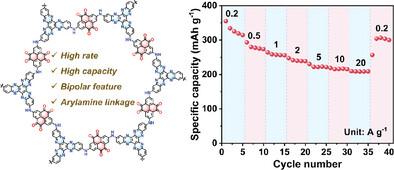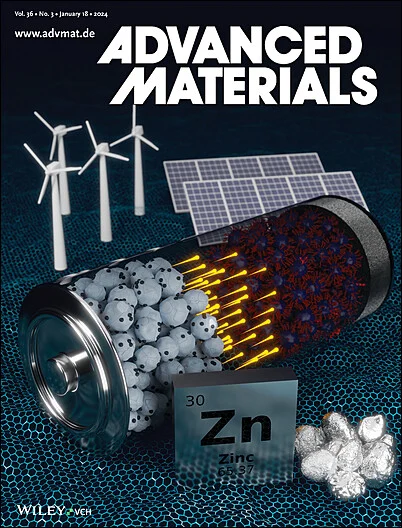Arylamine-Linked Porous Organic Polymers with Abundant Redox-Active Sites as High-Capacity and High-Rate Organic Cathodes for Lithium-Ion Batteries
IF 27.4
1区 材料科学
Q1 CHEMISTRY, MULTIDISCIPLINARY
引用次数: 0
Abstract
Redox-active porous organic polymers (POPs) have emerged as promising and sustainable organic cathode materials (OCMs) for lithium-ion batteries (LIBs). However, their performance is significantly limited by insufficient redox-active sites and low intrinsic conductivity. Herein, a series of novel arylamine-linked and bipolar POPs (denoted as HATN-AQ, HATN-BQ, HATN-CBD, and HATN-PTO) are designed and prepared as OCMs for LIBs. Benefiting from their high density of redox-active sites, bipolar feature, and arylamine linkage, these POPs exhibited high capacity, high rate, and excellent long-term cycling stability. Among them, HATN-PTO displayed an ultrahigh reversible capacity of 329.6 mAh g−1 at 0.2 A g−1 with a high energy density of 716.7 Wh kg−1, outstanding rate performance (208.7 mAh g−1 at 20 A g−1), and superior cycling stability (188.9 mAh g−1 capacity retained after 500 cycles at 1 A g−1). Furthermore, the HATN-PTO//graphite full battery exhibited a high specific capacity of 227.3 mAh g−1 at 0.2 A g−1 and maintained a high capacity of 99.1 mAh g−1 after 200 cycles at 0.5 A g−1. Ex situ FT-IR and XPS spectra combined with theoretical calculations are employed to elucidate the dual-ion storage mechanism. This work provides an effective strategy for designing POPs with high-capacity and high-rate for OCMs.

求助全文
约1分钟内获得全文
求助全文
来源期刊

Advanced Materials
工程技术-材料科学:综合
CiteScore
43.00
自引率
4.10%
发文量
2182
审稿时长
2 months
期刊介绍:
Advanced Materials, one of the world's most prestigious journals and the foundation of the Advanced portfolio, is the home of choice for best-in-class materials science for more than 30 years. Following this fast-growing and interdisciplinary field, we are considering and publishing the most important discoveries on any and all materials from materials scientists, chemists, physicists, engineers as well as health and life scientists and bringing you the latest results and trends in modern materials-related research every week.
 求助内容:
求助内容: 应助结果提醒方式:
应助结果提醒方式:


